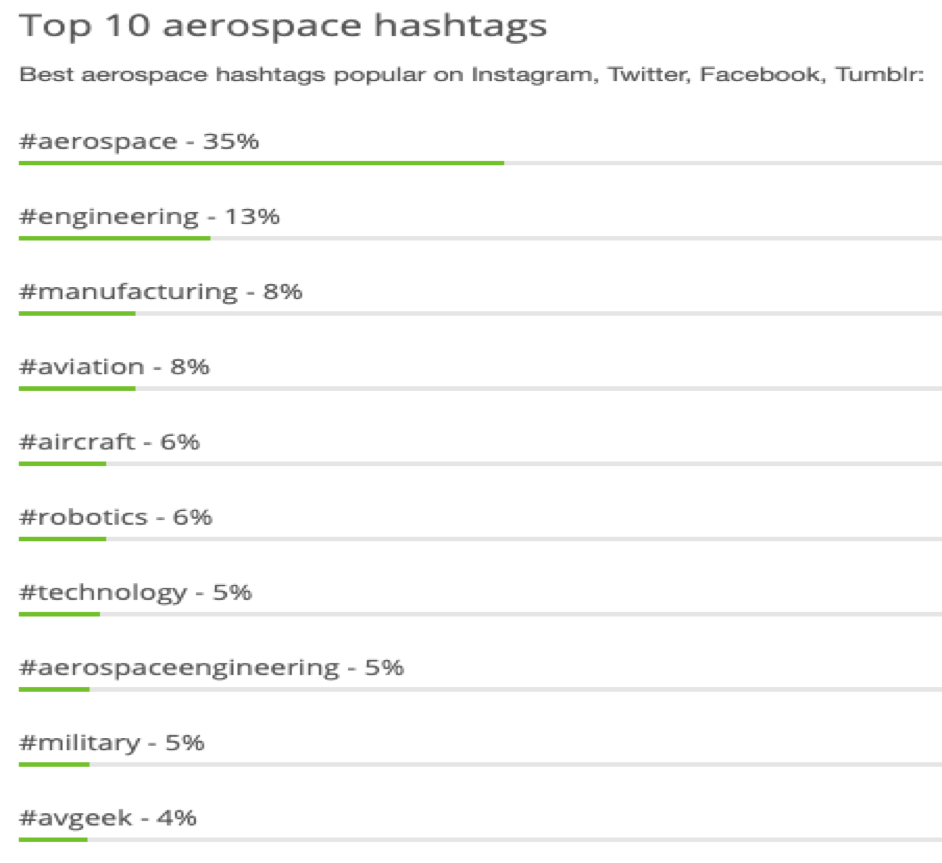Abstract
This report considers the role of social media marketing in the aerospace industry. What is not always obvious from casual readings on this subject is the highly technical underpinnings of the effective use of this marketing approach. Aerospace marketers often outsource the detailed technical analysis to social media marketers which tend to use deep learning to perform this. These service providers seem to operate as custodians of black boxes.

The use of Deep Learning and Embeddings
The concept of embeddings goes hand-in-hand with categorical variables. Individual words in an aerospace related social media document can be considered “values” or categories of a “text” variable. The analyst gets to choose the number of dimensions in semantic space along which the words will be placed. This means each word gets an embedding vector of N dimensions and is placed inside an N-dimensional semantic space. Figure 2 shows an example of word embeddings (albeit not aerospace words), visualized in a 2-dimensional semantic space. The clustering of words in this space becomes key in identifying, relating, and analyzing the nature of the text. The usefulness of word embeddings was first described by Collobert and Weston (2008).

Ben-Lhachemi and Nfaoui (2018) realize that using word embeddings as such does not go far enough. The combined meaning of all the words in a tweet should somehow be captured in a single tweet embedding. The question is how to combine individual word embeddings. To address this, they made use of the work by Arora, Liang, and Ma (2017). This paper describes a simple but tough-to-beat technique to create sentence embeddings. In other words, it shows how to combine individual word embeddings and consolidate them into a single sentence embedding. Ben-Lhachemi and Nfaoui (2018) equated their collection of words (a tweet) to a sentence. Combining word embeddings was not invented by Arora et al. (2017). Similar approaches (that include the combination of word embeddings in terms of phrases, sentences, and even paragraphs) were described by Iyyer, Manjunatha, Boyd-Graber, and Daumé III (2015), Le and Mikolov (2014), Kiros et al. (2015), Socher, Huang, Pennin, Manning, and Ng (2011), Blunsom, Grefenstette, and Kalchbrenner (2014), Tai, Socher, and Manning (2015), and Wang et al. (2016).
The next step for aerospace marketers is to apply the technique described in Ben-Lhachemi and Nfaoui (2018), or described elsewhere in similar papers, to bolster the analysis abilities of their automated systems.
References
Engineering 360 (2019). Retrieved June 17, 2019, from https://www.globalspec.com/
Wilinsky, D. (2014, September). IHS Introduces Engineering360, the World’s Largest Online Destination for Engineers. Retrieved from https://www.businesswire.com/news/home/20140925005599/en/IHS-Introduces-Engineering360-the-World%E2%80%99s-Largest-Online-Destination-for-Engineers
5 Online Communities About the Aviation Industry You Should Join. http://www.aviationmaintenance.edu/blog/aviation-industry/5-online-communities-aviation-industry-join/
15 Aerospace Industry Professionals You Should Be Following on Social Media. https://www.cuttingdynamics.com/industry-professionals-you-should-follow-on-social-media/
Knoblich, S., Martin, A., Nash, R., & Stansbie, P. (2017). Keys to success in Social Media Marketing (SMM) – Prospects for the German airline industry. Tourism and Hospitality Research, 17(2), 147–164. https://doi.org/10.1177/1467358415610415
Ben-Lhachemi, N. & Nfaoui, E. (2018). Using Tweets Embeddings For Hashtag Recommendation in Twitter. Procedia Computer Science, 127(2018), 7–15.
Collobert, R. & Weston, J. (2008). A unified architecture for natural language processing: Deep neural networks with multitask learning. In Proceedings of the 25th International Conference on Machine Learning, Helsinki, Finland, 2008.
Arora, S. Liang, Y., Ma, T. (2017). A SIMPLE BUT TOUGH-TO-BEAT BASELINE FOR SENTENCE EMBEDDINGS. Submitted to ICLR 2017 conference.
Iyyer, M., Manjunatha V., Boyd-Graber, J., Daumé, H. III. (2015). Deep unordered compositionrivals syntactic methods for text classification. Proceedings of the Association forComputational Linguistics, 2015.
Le, Q. & Mikolov, T. Distributed representations of sentences and documents. In Proceedings of The 31st International Conference on Machine Learning, 2014.
Kiros, R., Zhu, Y, Salakhutdinov, R., Zemel, R., Urtasun, R, Torralba, A., Fidler, S. Skip-thought vectors. In Advances in neural information processing systems, 2015.
Socher, R., Huang, E. H., Pennin, J., Manning, C. D., Ng, A. Y. Dynamic pooling and unfolding recursive autoencoders for paraphrase detection. In Advances in Neural Information Processing Systems, 2011.
Blunsom, P., Grefenstette, E., Kalchbrenner, N. A convolutional neural network for modelling sentences. In Proceedings of the 52nd Annual Meeting of the Association for Computational Linguistics, 2014.
Tai, K. S., Socher, R., Manning, C. D. Improved semantic representations from tree-structured long short-term memory networks. arXiv preprint arXiv:1503.00075, 2015.
Wang, Y., Huang, H., Feng, C., Zhou, Q., Gu, J., Gao, X. Cse: Conceptual sentence embeddings based on attention model. In Proceedings of the 54th Annual Meeting of the Association for Computational Linguistics (Volume 1: Long Papers), 2016.
Lexalytics.com: https://www.lexalytics.com/
Salesforce Radian6: https://socialstudio.radian6.com
IBM Cloud: https://www.ibm.com/cloud/
AviationBusinessConsultants.com: https://aviationbusinessconsultants.com
Ansys: https://www.ansys.com/solutions/solutions-by-industry/aerospace-and-defense
Sprout Social CASE STUDIES: How Simply Measured Continues to Help ANSYS Grow Their Social Engagement by 19% Year-Over-Year. https://sproutsocial.com/insights/case-studies/ansys/
Seo & Park (2018). A Study on the Effects of Social Media Marketing Activities on Brand Equity and Customer Response in the Airline Industry. Journal of Air Transport Management 66 (2018): 36-41. Web.
Studies in the Area of Air Transport Management Reported from Korea Aerospace University. Marketing Weekly News (2018): 66. Web.


Social Media Marketing
The nature of social media conversations span a wide range. At the one extreme, there is gossip around celebrity activities, comments about the breakfast someone just finished, or maybe that her cat had a litter of 5 kittens at midnight. These types of exchanges could be classified as shallow and broad. Some refer to these connection patterns as social networks. The objective of participants is simply to link and have conversations. There are relatively few of these networks but they are large. At the other extreme we find exchanges that can be very focused and deep. These exchanges are made on networks referred to as virtual communities which are smaller in size but much more numerous. The objective of participants is not primarily to communicate, but to accomplish a task or mission. They want guidance from influencers and experts rather than peers on topics they care about. One example is Engineering 360. In a 2014 news report, Wilinsky, describes it as the world’s largest virtual community for engineers. A few smaller communities are outlined in the article 5 Online Communities About the Aviation Industry You Should Join.
Authority Brands
To target the aerospace industry, marketers continuously identify appropriate communities of aerospace influencers and experts and are positioning themselves to “develop” them. For example, 15 Aerospace Industry Professionals You Should Be Following on Social Media identifies some influencers to follow on social media. The emphasis is on very relevant content marketing to keep the community members informed on the latest developments in the industry and to address their needs as closely as possible. Marketers are striving to position their companies as authority brands rather than engaging in traditional advertising. This leads to relationships founded on value rather than purchase transactions. In addition, these relationships connect the company with high value audiences and markets. The members become consumers of this content rather than products and services. Marketers realize that they should support their virtual communities and help them achieve their missions, rather than to engage in traditional advertising. Whenever members are ready to buy, they will come back to the authority brand’s content offerings and tend to seek its advice to initiate purchasing.